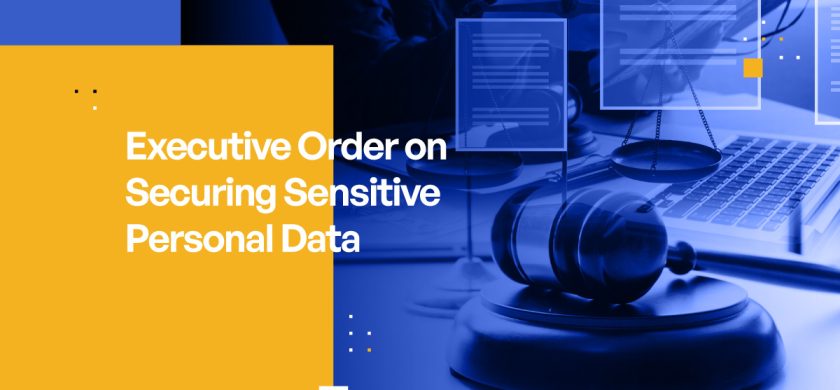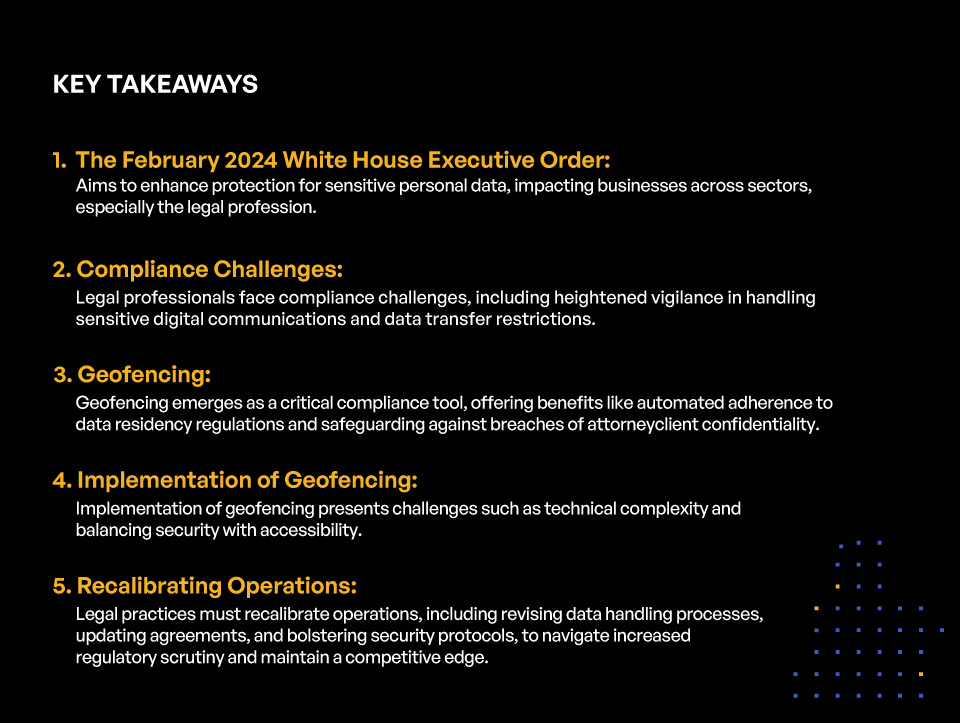
Understanding the Biden Executive Order on Securing Sensitive Personal Data
Kiteworks’ General Counsel Camilo Artiga-Purcell just published an article in Law360 addressing the White House Executive Order on Data Privacy that many will find useful. He delineated five implications for legal professionals and spelled out nine data protection recommendations for readers.
The February 2024 White House Executive Order aims to strengthen the protection of sensitive personal data. This order has far-reaching implications for businesses across all sectors, but it is especially pertinent for the legal profession, where the confidentiality of client information is of utmost importance.
As a provider of sensitive content communications solutions, Kiteworks recognizes the significance of this executive order and the challenges it presents for legal professionals. In this blog post, we’ll explore the key aspects of the order, its potential impact on legal practices, and the steps that can be taken to ensure regulatory compliance and maintain a competitive edge.
Compliance Challenges for Legal Professionals
The executive order extends beyond the basic protection of personal data, encompassing all forms of digital communication that may convey sensitive information. This means that legal professionals must exercise heightened vigilance in their handling and exchange of confidential client data.
Data Transfer Restrictions
One of the primary challenges imposed by the order is the restriction on data transfers. Legal practices must now scrutinize their data flows and implement robust mechanisms to prevent unauthorized cross-border transfers of sensitive content. This often requires significant investments in technology and training to ensure compliance with various international legal frameworks like GDPR, DPA 2018, PIPEDA, and others.
Reconciling Federal Mandates with International Laws
Complying with the executive order is further complicated by the need to reconcile federal mandates with a patchwork of international laws. The varying definitions of “sensitive content” across jurisdictions can make it difficult for legal professionals to navigate this complex regulatory landscape.
Role of Geofencing in Compliance
Data localization, and geofencing in particular, emerges as a critical tool for legal professionals in their efforts to comply with data transfer restrictions. By creating virtual boundaries, geofencing ensures that sensitive data does not cross geographical borders without proper authorization.

KEY TAKEAWAYS
- The February 2024 White House Executive Order:
Aims to enhance protection for sensitive personal data, impacting businesses across sectors, especially the legal profession. - Compliance Challenges:
Legal professionals face compliance challenges, including heightened vigilance in handling sensitive digital communications and data transfer restrictions. - Geofencing:
Geofencing emerges as a critical compliance tool, offering benefits like automated adherence to data residency regulations and safeguarding against breaches of attorneyclient confidentiality. - Implementation of Geofencing:
Implementation of geofencing presents challenges such as technical complexity and balancing security with accessibility. - Recalibrating Operations:
Legal practices must recalibrate operations, including revising data handling processes, updating agreements, and bolstering security protocols, to navigate increased regulatory scrutiny and maintain a competitive edge.
Benefits of Geofencing for Legal Practices
Implementing geofencing offers several key benefits for legal practices:
- Automated compliance with data residency regulations
- Safeguarding against inadvertent breaches of attorney-client confidentiality
- Real-time alerts and automated blocks on sensitive content attempting to cross restricted geo-boundaries
- Effective mitigation of regulatory risks
Challenges of Geofencing Implementation
While geofencing is a powerful compliance tool, its implementation comes with certain challenges:
- Technical complexity in defining precise geographical boundaries, especially in areas with ambiguous regulatory demarcations
- Balancing security with accessibility to avoid hindering legitimate international communications and collaborations
Operational Challenges and Necessary Recalibrations
To comply with the executive order, legal practices must undertake a comprehensive recalibration of their operations. This involves:
Revising Data Handling Processes
Data handling processes must be overhauled to address the nuances of sensitive content. This includes data classification based on sensitivity, establishing clear communication channels, and incorporating stringent access controls.
Updating Agreements with Partners and Vendors
Agreements with partners and vendors must be scrutinized and updated to include clauses that enforce compliance with the order’s mandates. These agreements should clearly articulate responsibilities and liabilities associated with data breaches and unauthorized handling of sensitive communications.
Bolstering Security Protocols
Legal practices must bolster their security protocols to ensure secure, monitored, and compliant mechanisms for communication in an evolving regulatory landscape.
Increased Regulatory Scrutiny and Proactive Compliance
The executive order heightens the potential for increased regulatory scrutiny over the management of sensitive content communications. Legal entities can anticipate more frequent audits, deeper investigations into data handling practices, and a higher bar for compliance reporting.
To avoid pitfalls and demonstrate a commitment to data protection, legal practices should:
- Conduct regular compliance check-ins
- Engage in continuous staff training
- Establish a culture of compliance from the top down
- Stay abreast of changes in regulatory standards
Navigating the Competitive Landscape
Compliance with the executive order is not just a legal necessity; it also offers a competitive edge to those who navigate its complexities with finesse. Companies that demonstrate robust adherence to the order will likely be viewed as trustworthy stewards of sensitive content communications, attracting clients who prioritize data security.
Action Steps for Achieving Compliance and Competitive Advantage
To achieve compliance and gain a competitive edge, legal practices should undertake several key action steps:
- Conduct comprehensive compliance checks and training
- Overhaul data handling processes and incorporate stringent access controls
- Update agreements with partners and vendors to enforce compliance
- Implement geofencing to orchestrate data transfer restrictions
- Bolster security protocols for secure and compliant communication
- Stay updated on evolving regulatory standards
- Embrace opportunities for innovation in compliance solutions
- Cultivate a culture of compliance from the top down
- Establish an incident response plan and ensure stakeholder preparedness
- Purchase adequate cyberinsurance coverage
Using Kiteworks to Navigate the New Regulatory Landscape
The Biden executive order on securing sensitive personal data presents significant challenges for the legal profession, necessitating a recalibration of practices to uphold the sanctity of attorney-client confidentiality. As a trusted provider of sensitive content communication solutions, Kiteworks recognizes the importance of adapting to this new regulatory landscape.
By prioritizing compliance, embracing innovative solutions, and cultivating a culture of data protection, legal practices can navigate the complexities of the executive order with confidence. In doing so, they not only uphold the rule of law but also fortify the trust placed in the legal system.
At Kiteworks, we are committed to helping legal professionals in law firmsand corporate legal departments meet the challenges of secure sensitive content communications in the face of evolving regulations. Our solutions are designed to facilitate compliance, bolster security, and maintain the highest standards of data protection. As the legal profession stands at the intersection of compliance and security, Kiteworks stands ready to support you in navigating this critical juncture with confidence.
The Kiteworks Private Content Network, a FIPS 140-2 Level validated secure file sharing and file transfer platform, consolidates email, file sharing, web forms, SFTP and managed file transfer, so organizations control, protect, and track every file as it enters and exits the organization.
Kiteworks deployment options include on-premises, hosted, private, hybrid, and FedRAMP virtual private cloud. With Kiteworks: control access to sensitive content; protect it when it’s shared externally using automated end-to-end encryption, multi-factor authentication, and security infrastructure integrations; see, track, and report all file activity, namely who sends what to whom, when, and how. Finally demonstrate compliance with regulations and standards like GDPR, HIPAA, CMMC, Cyber Essentials Plus, IRAP, and many more.
To learn more about Kiteworks Secure Managed File Transfer and its security, compliance, and automation capabilities, schedule a custom demo today.
Additional Resources
- Video The Road to the Data Requirement in Executive Order 14028
- Video Corporate Legal Works More Securely, Efficiently, and Intelligently With Kiteworks
- Case Study Husch Blackwell Enhances Communications and Increases Productivity With Secure File Sharing
- Blog Post Secure File Sharing for Law Firms and Lawyers: Ensuring Confidentiality in the Compliance Era
- Blog Post Preserve Client Confidentiality With Managed File Transfer: A Checklist for Law Firms